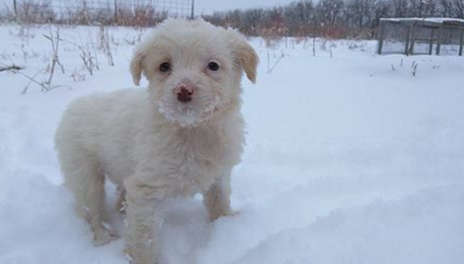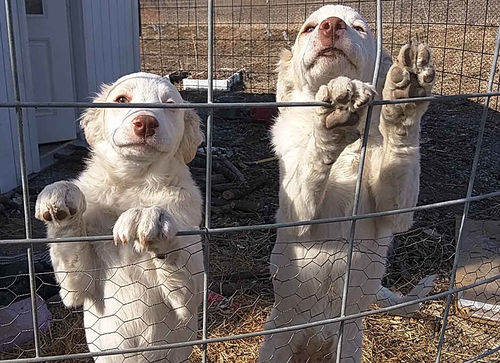Dogs Log
Jump to navigation
Jump to search
Mar 10, 2016
Jan 1, 2015
Wed Dec 30, 2015
Dogs are getting really lively -

Wed Dec 23, 2015
Snapped them up. 5 and 6 pounds are their weights. Turns out they were in sad shape. They had roundworms and one had a puffed eyebag. They got their initial vaccines.

Tue Dec 22, 2015
Guard/flock dog litters available near St. Joseph, MO:
- Pure-bred Pyrs (no papers) - $175 each - 1 male, 4 females - Albany, MO
- Maremma/Pyr cross (father Pyr, mother Maremma) - $150 each - 1 male, 1 female - Stewartsville, MO
Cost of vet care for large breed dogs (per dog) at the Maysville Vet:
- Initial: 2 x $38 for the first two rounds + $49 for the third round = $125 per dog
- Annual: $49 per dog
- $150 for spaying a female dog
- $130 for neutering a male dog
- Flea and tick spot-on prevention: $44.5 for 3 month supply
Equipment:
- 1 food bowl per dog
- 1 water bowl for both dogs
- 1 harness per dog
- 1 leash per dog (can be homemade from strong rope)
- 1 collar + ID tag per dog (can be homemade)
- 1 large bed for both dogs (could be just a blanket on straw)
- Gate or invisible fence to keep them from running out onto the road
- Dog door to enter and leave greenhouse at will
- They'll live in the greenhouse in the winter, but we may need to build them a shelter in the forest for summer use
- Pen - necessary only if we're to leave the farm for more than 3 days.
Regular supplies:
- Dog food (can be homemade) [http://www.walmart.com/search/?query=dog+food+50+lbs 50 lbs per dog per month @ $25 each)
- Treats (can be homemade)
- Flea and tick prevention (monthly) - $100 per dog per year
- Heartworm prevention (monthly) - $75 per dog per year
Expenses (per dog)
- Initial: $125 vaccines + $150 spaying + $25 equipment (bowls, leash, harness) + fence = $300
- Annual: $240 food (12 x $20) + $75 heartworm prevention + $100 flea and tick prevention + $50 vaccines = $420
Gender
- Dog owners tend to avoid having two male Pyrs - specially if they're not neutered, as they may end up fighting for dominance. Two unneutered males will almost certainly fight (unless one of them submits to the other, which is not likely in this breed). Two females may get along, but the odds improve if one or both of them are spayed. Sources:
- Like most livestock guardian and dominant breeds, Great Pyrenees usually don't get along with dogs of the same sex as adults. It's the rule rather than the exception, and we have seen many returns as a result. It may not happen immediately, but when the issue occurs, there's no "pause button" when two pyrs of the same sex are fighting.
- two mature Pyrenees of the same sex often do not get along well together
- Some females will tolerate other females, others won't, especially if they are not altered. For best results, have one or both of the females altered. Altering early by 6 months of age will also help reduce problems as well. Same sex pairings of two male Great Pyrenees is sheer madness and will likely end in tragedy with expensive vet bills and heartache if the other dog refuses to submit to it, which is typically unlikely with two male Pyrs. For best results, avoid any same sex pairings of any dominant or potentially dominant breed.
- Our dogs are neutered males, and they love each other. People usually don't suggest keeping two male Great Pyrenees together. But our dogs have grown up together and seem to really love each other. The younger one does not challenge the older one.
Pyr Training
- Great Pyrenees Characteristics
- "Great Pyrenees are intuitive, independent thinkers and formidable protectors and companions who may seem almost human at times; they aren't big, white golden retrievers looking to please. They are NOT herding dogs; they GUARD. This behavior extends to their human family and their defined property.
- They are independent thinkers, and are not easily obedience-trained. Owners need to understand and have patience to train a dog who feels he knows better than you do but will respond positively to the loving bond they develop with a strong and confident pack leader, aka the "alpha." If there is a void in pack leadership, rest assured that the Pyr will be stepping in to take over. That's where understanding "Nothing in Life is Free" training techniques and how to be an alpha pack leader create a well-behaved dog. With a Pyr, every day is training day.
- Pyrs are roamers and require secure, above-ground fencing, preferably at least 5 feet high. Invisible fencing will not keep a Pyr on its property, or keep out strange dogs or other animals. Pyrs consider strange canines (and humans) to be predators and will act accordingly.
- Like most livestock guardian and dominant breeds, Great Pyrenees usually don't get along with dogs of the same sex as adults. It's the rule rather than the exception, and we have seen many returns as a result. It may not happen immediately, but when the issue occurs, there's no "pause button" when two pyrs of the same sex are fighting. If it happens, be prepared by reading this page: http://sonic.net/~cdlcruz/GPCC/library/dogfight.htm.
- A Pyr off-leash, outside of a fenced area, is called "dis-a-Pyr" and will rarely turn around and come home after visiting around your neighborhood.
- Pyrs drool, some more than others, males usually more than females. If you can't tolerate drool, don't get a Pyr.
- Pyrs dig deep craters in your yard to keep cool, even in expensive landscaping.
- Pyrs bark as part of their guarding routine, and many have been surrendered to rescue as a result of noise complaints that have prompted legal action. Females can be a bit more vocal, but all Pyrs bark as part of their natural behavior. Barking is their first line of defense against predators.
- Pyrs are nocturnal and will still be on guard (and barking) at night, just as they would be as flock guards." (source)
